
Beyond the Pane: What Makes European Windows Unique
Share
What Makes European Windows Different from American Windows
European Windows represent a fundamentally different approach to window design and engineering compared to traditional American windows. While American windows typically focus on cost-effectiveness and ease of installation, European windows prioritize performance, energy efficiency, and long-term durability.
Key differences include:
- Opening mechanism: European windows feature tilt-and-turn functionality - they can tilt inward from the top for ventilation or swing fully inward like a door for cleaning and emergency egress
- Glazing: Triple glazing is standard in Europe vs. double glazing common in America
- Locking system: Multi-point locking hardware vs. single or double-point locks
- Air sealing: Multiple gaskets and continuous seals vs. basic weatherstripping
- Energy performance: Superior U-values (typically 0.13-1.0) vs. standard American windows (0.25-0.35)
As one architect noted after installing European windows: "When you stand near these windows, it isn't cold. We live where the jets go by, and you don't even hear them."
The tilt-and-turn functionality sets European windows apart most dramatically. With a simple turn of the handle, these windows either tilt from the top for secure, draft-free ventilation or swing fully inward for easy cleaning and emergency access. This dual operation, combined with advanced glazing packages and multi-chamber profiles, delivers exceptional thermal insulation and acoustic performance.
We specialize in distributing premium European Windows with German engineering and tilt-and-turn functionality for over a decade. My experience helping homeowners transition from traditional American windows to high-performance European systems has shown me how these windows transform both comfort and energy efficiency.
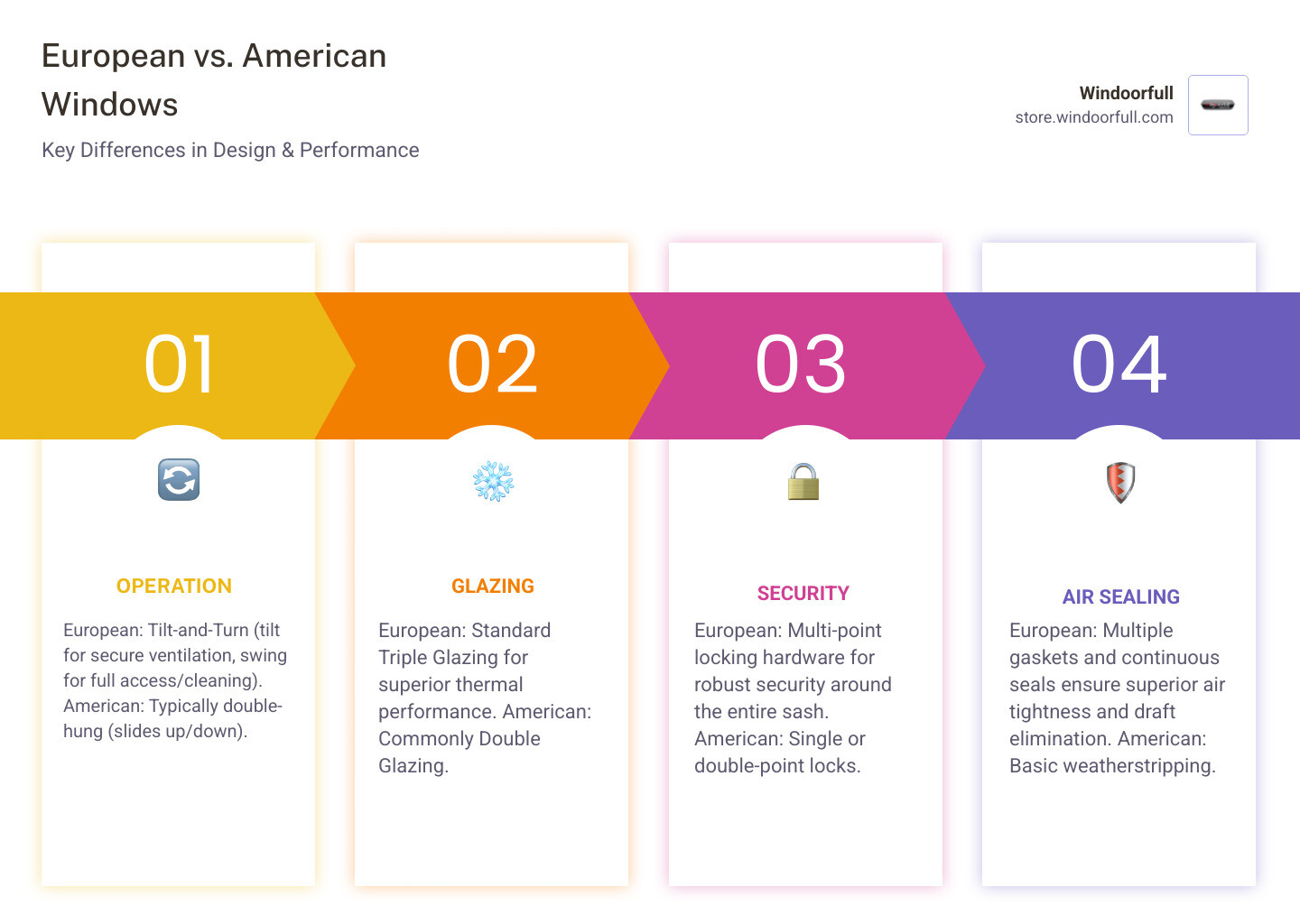
The Engineering Advantage of European Windows: Performance, Efficiency, and Security
Comparing European Windows to typical American windows reveals two different philosophies. American windows often prioritize keeping costs low and making installation simple. European windows? They're engineered with one goal in mind: delivering the best possible performance, no matter what.
This difference shows up everywhere. European manufacturers use multi-chamber profiles that create internal air pockets for insulation. They build frames from durable materials like uPVC and aluminum that can support massive glass panes—we're talking nearly five feet wide and eight feet tall—without losing strength or thermal performance. It's like comparing a basic sedan to a luxury car; the experience is worlds apart.
Here's how European Windows stack up against standard American options:
| Feature | Typical European Windows | Standard American Windows |
|---|---|---|
| Glazing | Triple glazing (de facto standard, up to 2 inches thick) | Double glazing (common, typically up to 7/8 inches thick) |
| Locking System | Multi-point locking hardware | Single or double-point locks |
| Air Seals | Multiple gaskets (three or four) and continuous seals | Basic weatherstripping |
| U-Factor Range | Excellent (often down to 0.13) | Moderate (typically 0.25-0.35) |
| Frame Design | Multi-chamber profiles, thermal breaks | Simpler profiles, less emphasis on thermal breaks |
| Opening Style | Tilt-and-turn, inward opening casement | Double-hung, outward opening casement |
| Durability | Engineered for long life cycles and minimal maintenance | Varies, often with shorter expected lifespan |
Best Energy Efficiency
The energy efficiency of European Windows is in a different league. While American homeowners are often happy to get double-pane windows, Europeans consider triple glazing the bare minimum for new construction.
Triple glazing is the European standard for good reason. Instead of two panes of glass, you get three, often separated by argon gas for extra insulation. European triple glazing can reach up to 2 inches thick, compared to the 7/8 inches you'll typically see in American double-pane windows. That extra thickness isn't just for show—it dramatically reduces how much heat escapes through your windows.
Low-E coatings and argon gas fills take things even further. These microscopic coatings reflect heat back into your home during winter and keep it out during summer. Combined with argon gas between the panes (which is denser than air and slows down heat transfer), you get thermal performance that would make your old windows blush.
Multi-chamber profiles and thermal breaks in the frames themselves act like built-in insulation. These internal air pockets prevent heat from conducting through the frame material. For aluminum frames, thermal breaks—polymer cores that separate the interior and exterior parts—stop thermal conduction in its tracks.
The result? European windows often achieve U-values as low as 0.13, which translates to dramatically lower energy bills and a more comfortable home year-round. Want to dive deeper into this technology? Check out our guides on The Ultimate Comfort: Why Choose Triple Glazed Tilt and Turn Windows and Beyond Double is Triple Glazing: The Smart Choice for Your Home.
Superior Security and Durability
Security isn't an afterthought with European Windows—it's built into every component. The difference starts with the locking system and extends through every aspect of construction.
Multi-point locking hardware is where European windows really shine. Instead of one or two lock points like American windows, European windows lock at multiple points around the entire frame. When you turn the handle, several locking mechanisms engage simultaneously, creating a seal that's incredibly difficult to breach. The hardware is often German-engineered, known for precision that keeps working smoothly for decades.
Steel-reinforced frames add another layer of security and strength. Many uPVC European windows include steel reinforcement within their multi-chamber profiles. This prevents warping and makes forced entry extremely difficult. It's like having a security system built right into your window frame.
Robust construction and high-quality materials ensure these windows last. European manufacturers use rigorous quality control and premium materials that stand up to decades of use. The frames won't warp, the hardware won't fail, and the seals won't deteriorate like they might with lower-quality alternatives.
This attention to detail means fewer repairs, less maintenance, and windows that continue performing at their peak for many years. For more details on the engineering behind this hardware, read Smooth Moves: A Guide to Tilt-Turn Window and Door Hardware.
Improved Comfort and Acoustics
There's something magical about stepping into a home with European Windows. The outside world doesn't just look different through the glass—it sounds different too. Or rather, you don't hear it at all.
Exceptional soundproofing and noise reduction happen naturally when you combine triple glazing with multi-chamber profiles. European windows typically achieve Class 4 soundproofing (RW=44 dB), and can be upgraded to Class 6 (50 dB) for homes near airports or busy roads. Traffic noise, barking dogs, leaf blowers—they all fade into the background.
Draft elimination and consistent indoor temperature make your home feel completely different. The multiple gaskets and continuous air seals create such tight closure that cold spots near windows become a thing of the past. You can stand right next to a European window on the coldest day and feel perfectly comfortable.
This changes your home into a true sanctuary. No more cranking up the heat because it's drafty near the windows. No more dealing with condensation issues. Just consistent, comfortable temperatures throughout your home, regardless of what's happening outside.
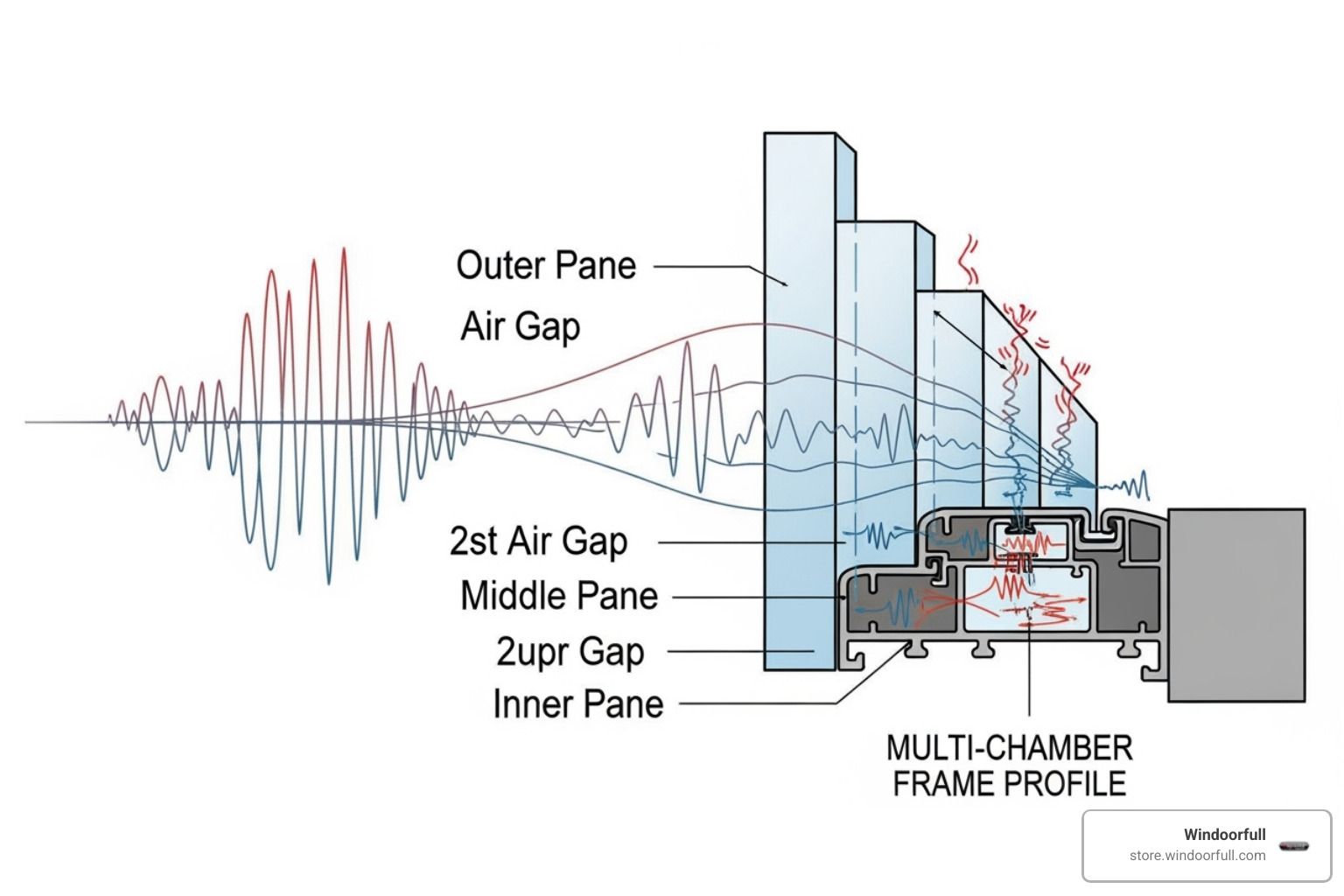
A Guide to European Window Styles and Materials
European Windows bring something special to home design that goes far beyond just function. They offer incredible aesthetic versatility and modern appeal that can transform how your home looks and feels. Unlike traditional windows that break up wall space with visible seams and frames, European windows create expansive glass areas that flood your interior with natural light.
This creates those airy, open spaces you see in luxury magazines - that seamless connection between your indoor and outdoor living areas. It's like bringing the outside in, but without the bugs or weather!
We believe your creativity shouldn't be limited by what's available on the shelf. That's why our windows come in a remarkable range of sizes, shapes, and colors. Want a window that's nearly eight feet tall? No problem. Need a custom color to match your home's unique style? We've got you covered. To learn more about this design philosophy, check out Continental Charm: Unpacking Euro-Style Windows.
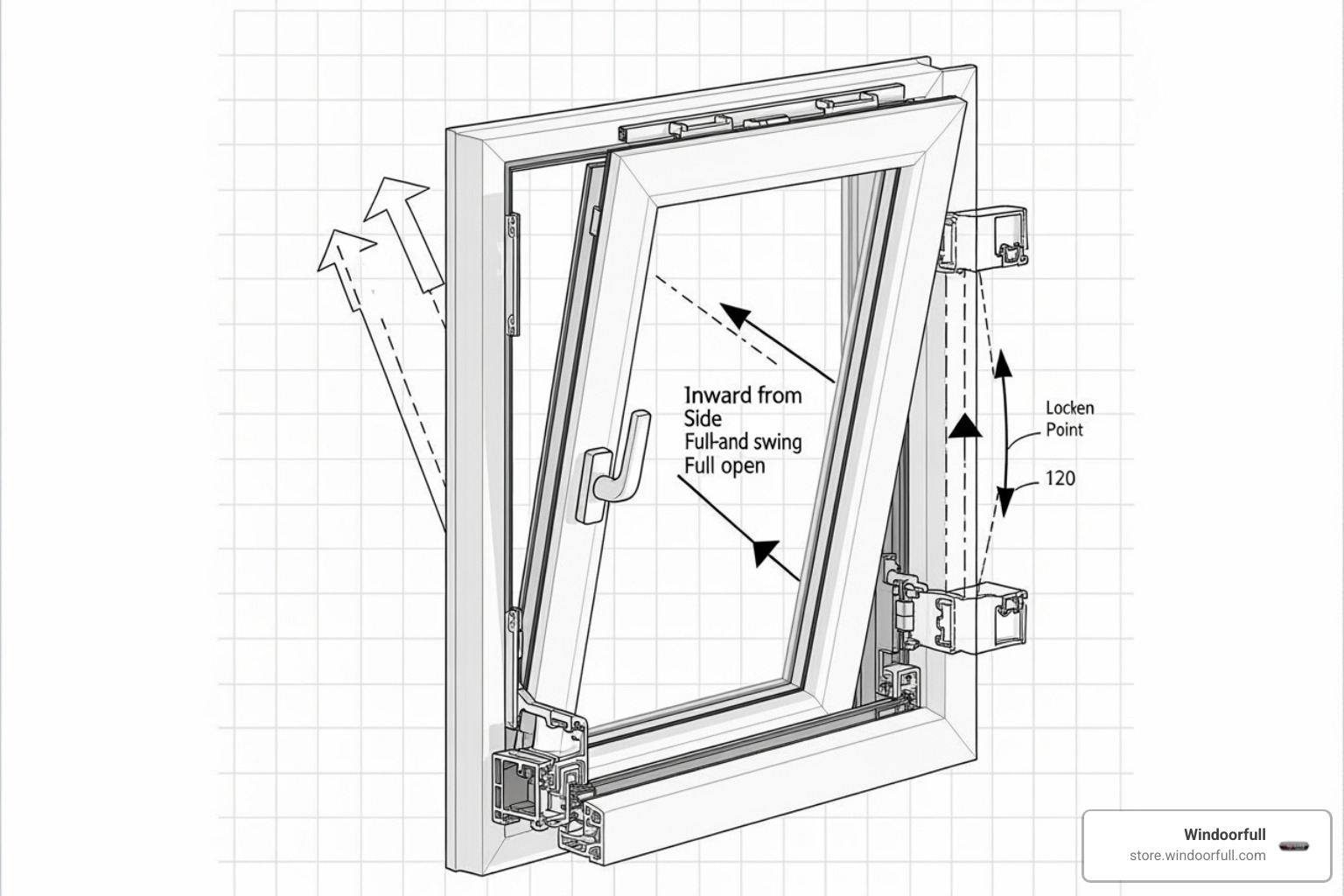
Popular European Window Styles
When people think of European Windows, the tilt-and-turn style usually comes to mind first - and for good reason. But there's actually a whole family of European window styles, each designed for specific needs and architectural visions.
Tilt and Turn Windows are our specialty and the star of European design. With just one handle, you get two completely different functions. Turn it one way, and the window tilts inward from the top - perfect for getting fresh air without worrying about rain coming in or curious pets getting out. Turn the handle the other way, and the entire window swings inward like a door, giving you maximum airflow and making cleaning from inside your home incredibly easy.
These windows are also your emergency exit if needed, which is pretty neat when you think about it. Our article Beyond the Hinge: Everything You Need to Know About Tilt-Turn Windows covers all the benefits in detail.
Inward-Opening Casement Windows work similarly to the "turn" function of tilt-and-turn windows, but without the tilting option. They swing fully inward, which might seem backwards if you're used to American windows that push outward. But there's real wisdom in this design - you can clean them easily from inside, and they create better seals when closed.
Fixed (Picture) Windows are perfect when you want maximum light and unobstructed views but don't need ventilation in that particular spot. Think of them as transparent walls that connect your indoor and outdoor spaces seamlessly. They're minimalist in the best way possible.
Hopper Windows are the smaller cousins that tilt inward from the top. They're fantastic for bathrooms, basements, or any space where you want privacy but still need air circulation.
Choosing between these styles can feel overwhelming, especially when comparing tilt-and-turn versus casement options. Our guide Which Window Wins? Tilt and Turn vs. Casement Explained breaks down the differences to help you make the right choice for your home.
Common Materials and Their Benefits
The material you choose for your European Windows frame makes a huge difference in how they perform, how much maintenance they need, and how they look in your home. We offer several high-quality options, each with its own personality and strengths.
uPVC is incredibly popular for good reasons. It's tough as nails, provides outstanding thermal insulation, and requires almost no maintenance. You can literally just wipe it clean and forget about it. It's also versatile in design and offers excellent energy efficiency without breaking the bank. While some people used to worry about environmental concerns with uPVC, modern manufacturing has come a long way. Our article Window Wonderland: Finding the Magic of Aluplast shows how innovative uPVC profiles deliver superior performance.
Aluminum brings strength and that sleek, modern look that works beautifully with contemporary architecture. It's surprisingly lightweight despite being incredibly durable, and it needs very little maintenance over its long life. Plus, aluminum is 100% recyclable, making it a smart environmental choice.
Wood appeals to people who love natural materials and traditional beauty. It provides excellent insulation naturally and actually contributes to a healthier indoor environment. You can stain or paint wood to match any decor style, from rustic farmhouse to neat traditional.
Alu-Clad combines the best of wood and aluminum in one package. You get the warmth and natural beauty of wood on the inside where you see and touch it daily, plus the weather resistance and low maintenance of aluminum on the outside where it faces the elements. It's a premium choice that delivers exceptional thermal insulation and durability.
All these materials share one important trait - they're selected for minimal maintenance requirements. That means your windows will look great and perform well for years to come, without you having to fuss over them constantly.
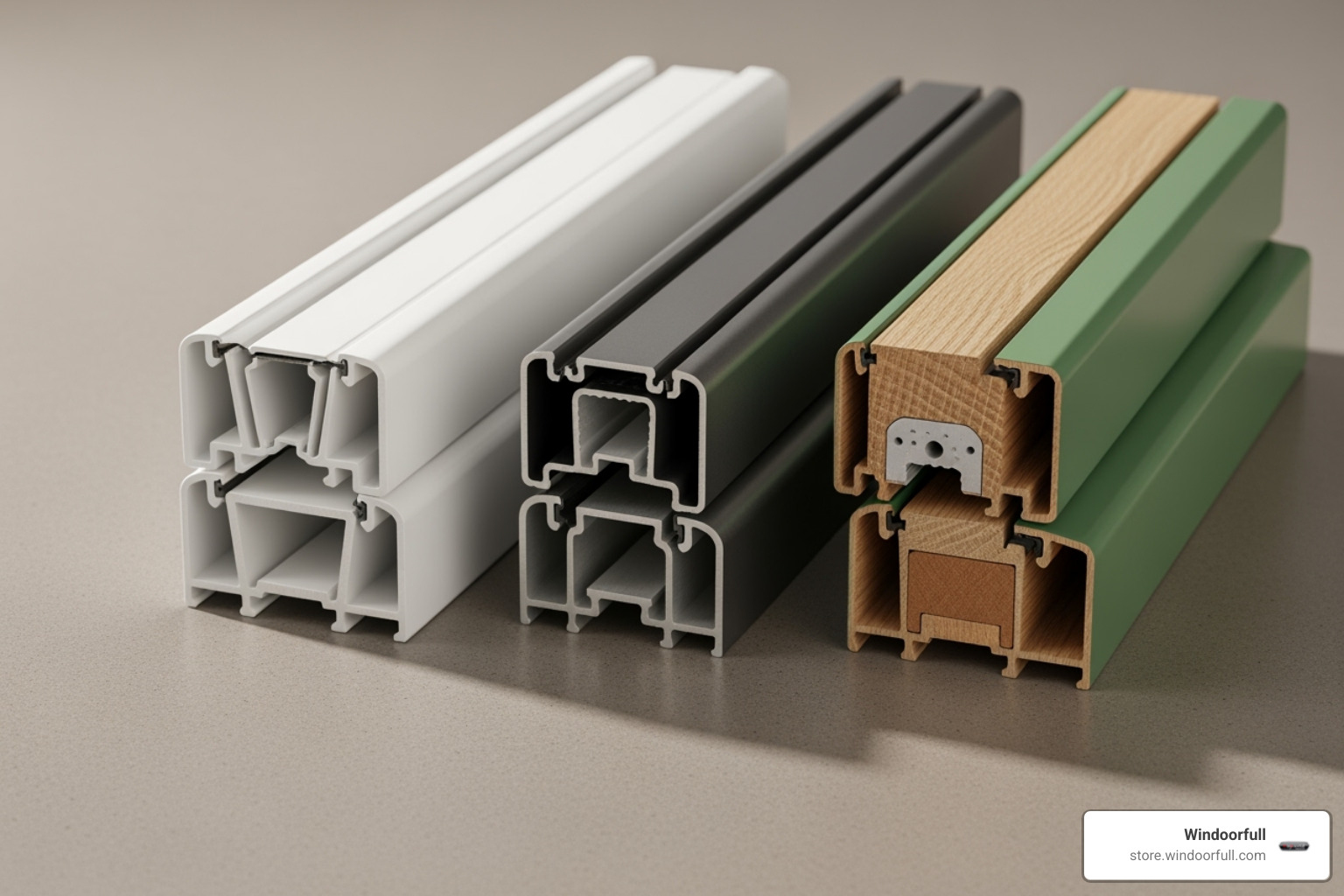
Bringing European Windows to Your US Home: A Practical Guide
Making the switch to European Windows in your American home is one of the smartest investments you can make for comfort and energy efficiency. But I understand it can feel overwhelming at first—you're dealing with different installation methods, wondering about costs, and maybe questioning if it's all worth it.
Let me put your mind at ease. After helping hundreds of homeowners make this transition over the past decade, I can tell you that bringing European engineering to American homes is not only possible but incredibly rewarding. The key is understanding what makes this process unique and planning accordingly.
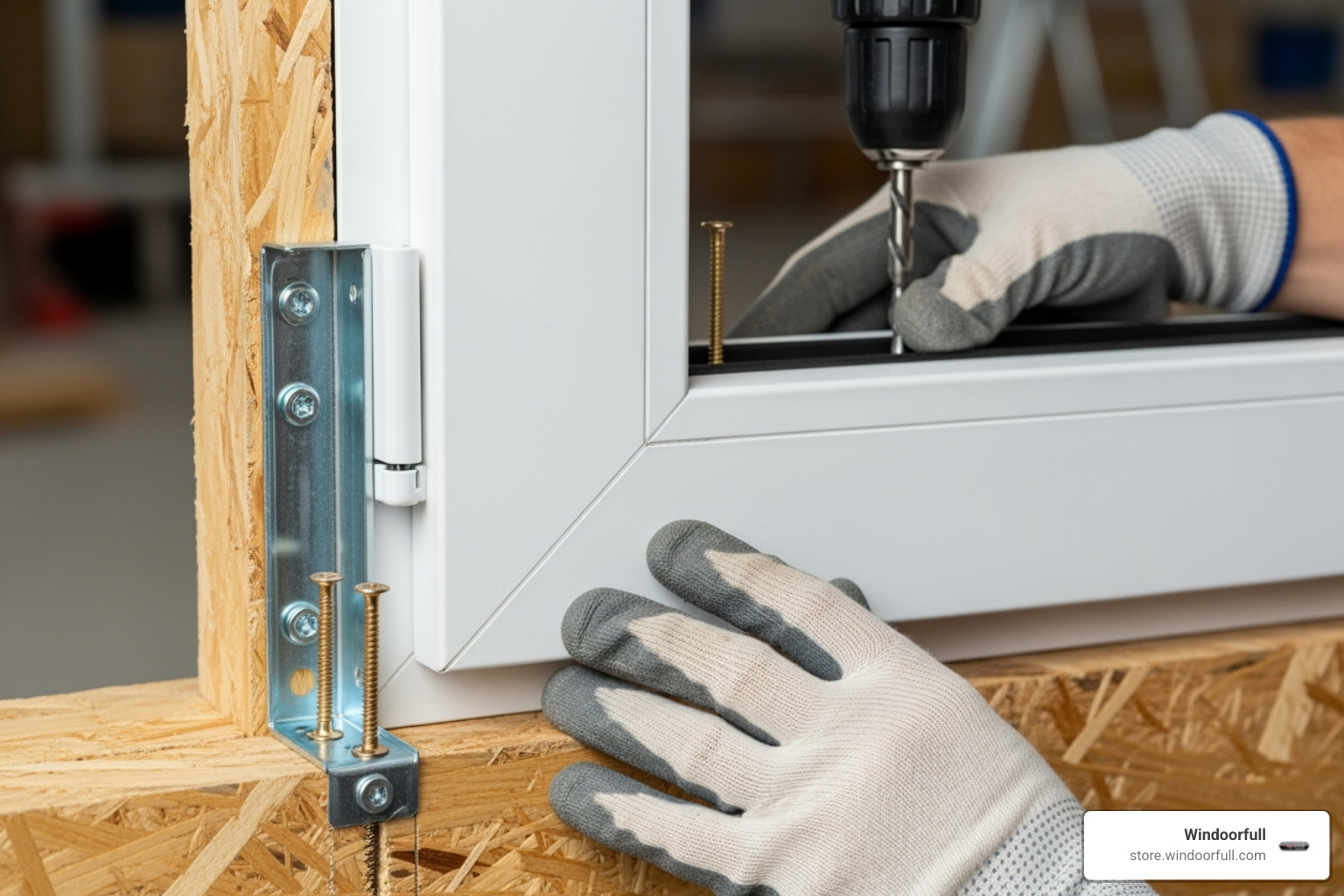
Key Considerations for Installing European Windows in the USA
The first question almost everyone asks me is: "Are European Windows even legal in the United States?" I'm happy to report that yes, they absolutely are! European windows are fully compliant with U.S. building standards and regulations. Many European manufacturers specifically design their products to meet or exceed American energy standards and obtain NFRC certification for U-Factor and Solar Heat Gain Coefficient guidelines.
The real difference lies in how these windows are installed. While American windows typically use nailing fins that attach directly to the exterior sheathing, European Windows use a bracket mounting system. Think of it like the difference between hanging a picture with a nail versus using wall anchors—both work perfectly, they're just different approaches.
This bracket installation method is actually quite neat. The frame gets secured to the rough opening with mounting brackets, creating a solid, weatherproof seal. Any experienced contractor can master this technique quickly with proper guidance. The key is communication upfront so your installer knows what to expect.
Building codes and egress requirements are another important consideration, especially for bedroom windows that need to serve as emergency exits. Our team always helps verify that your chosen windows meet local dimensional and operational requirements for safety. It's just part of doing things right.
Understanding the Cost and Investment Value
I won't sugarcoat it—European Windows typically require a higher upfront investment than basic American alternatives. A single tilt and turn window might start around $559, while larger units like tilt and slide patio doors can reach $3,199 or more, depending on size and features.
But here's what I always tell my customers: don't just look at the price tag, look at the value story. These windows are engineered to pay for themselves over time through energy savings alone. Consider that up to 30% of household energy escapes through poorly insulated windows and doors. When you upgrade to triple-glazed European Windows with superior sealing, you're looking at potential energy savings of hundreds of dollars annually.
The durability factor is huge too. While you might replace cheaper windows every 15-20 years, quality European windows can last 30-50 years with minimal maintenance. That's fewer headaches, fewer replacement costs, and more money in your pocket over the long haul.
Property value is another win. Homebuyers increasingly appreciate energy-efficient features, and the sleek aesthetics of European-style windows add undeniable curb appeal. We've designed our pricing to be American-friendly while maintaining authentic European engineering quality, so you get premium performance without the premium import markup.
Maintenance and Care
One of my favorite things about European Windows is how little fuss they require once installed. These windows are designed by engineers who understand that nobody wants to spend weekends maintaining their home's components.
Cleaning becomes almost enjoyable with tilt and turn functionality. You can clean both sides of the glass safely from inside your home—no more dangerous ladder climbing or hiring window cleaners for upper floors. Just tilt the window in, wipe down both sides, and you're done.
The multi-point locking hardware is built like a Swiss watch—precise, durable, and designed to operate smoothly for decades. An occasional drop of lubricant on moving parts is usually all the attention it needs.
For uPVC frames, maintenance couldn't be simpler. A quick wipe with mild soap and water keeps them looking new. No painting, no staining, no worrying about rot or weather damage. The multiple gaskets that provide superior air sealing are equally low-maintenance, typically lasting the life of the window.
This combination of performance and convenience is exactly what we showcase in our guide Euro Windows Unveiled: Top Picks for Seamless Design and Performance.
The bottom line? European Windows are designed to make your life better, not busier. They perform exceptionally well while requiring minimal attention—exactly what every homeowner wants.
Frequently Asked Questions about European Windows
After helping countless homeowners make the switch to European Windows, I've noticed the same thoughtful questions come up again and again. Let me share the answers that have helped families make confident decisions about their window upgrades.
Are European windows better than American ones?
This question gets to the heart of what makes a window truly great. While "better" depends on your priorities, European Windows consistently outperform in areas that matter most to homeowners: comfort, energy savings, and long-term value.
The difference starts with design philosophy. European manufacturers design for performance first, driven by strict building codes and high energy costs across Europe. American windows have traditionally focused on keeping initial costs low and installation simple, which often means compromising on long-term performance.
The technological gap is striking. While triple glazing is standard across Europe, many American windows still rely on double glazing from decades past. European Windows feature multi-point locking systems that secure at multiple points around the frame, compared to the single or double locks common in American designs. The air sealing alone tells the story - European windows use multiple continuous gaskets that create an almost airtight seal, while traditional American windows depend on basic weatherstripping.
Dr. Helen Sanders from Technoform North America puts it perfectly: the U.S. market has been slow to adopt these proven technologies, often sticking with techniques that are literally decades old.
When you stand next to European Windows on a cold winter day, you won't feel that familiar chill. When jets fly overhead, you won't hear them. That's the difference superior engineering makes in your daily comfort.
What is the main benefit of a tilt and turn window?
The genius of tilt and turn windows lies in their dual-functionality - one simple handle gives you two completely different ways to use your window, each perfect for different situations.
In the tilt position, your window opens inward from the top, creating secure ventilation that's both draft-free and weather-resistant. You can leave it tilted during light rain without water coming in, and it's secure enough that you can ventilate your home even when you're away. This position is perfect for maintaining fresh air circulation without fully opening your home to the elements.
Turn that same handle 90 degrees, and the window swings fully inward like a door. This gives you maximum airflow when you want it, but more importantly, it makes cleaning both sides of the glass incredibly easy and safe from inside your home. No more dangerous ladder climbing or struggling to reach the outside of upper-story windows.
This full-opening position also serves as an emergency egress route, which can be crucial for bedroom windows and upper floors. The versatility means one window style handles ventilation, cleaning, and safety - eliminating the compromises you'd normally have to make.
For a deeper dive into why this functionality transforms modern living, check out our guide: The Smart Choice for Modern Homes: Why Tilt and Turn Windows Belong in Your USA Home.
Are European windows more expensive?
The upfront cost of European Windows is typically higher than basic American windows, but this question misses the bigger financial picture. Smart homeowners look at the total cost of ownership, not just the initial price tag.
Energy savings create real payback. When up to 30% of your home's energy escapes through poorly insulated windows, the superior thermal performance of European windows translates directly into lower utility bills. The triple glazing, advanced sealing, and thermal breaks that drive the higher initial cost are the same features that cut your heating and cooling costs month after month, year after year.
Durability changes the math entirely. European Windows are engineered for exceptionally long life cycles using world-class materials and precision manufacturing. While you might replace standard windows multiple times over decades, quality European windows often last the lifetime of your home with minimal maintenance.
Several factors influence the final investment: your choice of materials (uPVC offers great value, while alu-clad provides premium performance), window size and complexity, glazing options, and any custom features. A basic European tilt and turn window might start around $559, while larger specialty units like tilt-slide patio doors can reach $3,199 or more.
The real question isn't whether European windows cost more initially - it's whether you want to pay once for windows that deliver decades of superior performance, or pay repeatedly for replacements while sacrificing comfort and energy efficiency along the way.
When you factor in energy savings, increased home value, and the elimination of replacement costs, European Windows often prove to be the more economical choice over time.
Conclusion
When you step back and look at everything we've covered, it becomes clear that European Windows represent more than just an upgrade—they're a complete change of how windows should work in your home. These aren't your typical windows that you install and forget about. They're engineered with a level of precision and thoughtfulness that shows in every detail, from the smooth operation of their tilt-and-turn mechanisms to the whisper-quiet comfort they bring to your living spaces.
The superior engineering behind European Windows isn't just impressive on paper—it translates into real, tangible benefits you'll experience every day. When winter winds are howling outside and you're standing next to your window without feeling a chill, that's the triple glazing and multi-chamber profiles at work. When your energy bills drop month after month, that's the advanced thermal performance paying dividends. When you can clean both sides of your second-story windows safely from inside your home, that's the brilliant tilt-and-turn functionality making your life easier.
What really sets these windows apart is how they balance best-in-class performance with genuine practicality. The multi-point locking systems don't just provide security—they create an airtight seal that keeps your home comfortable and quiet. The modern aesthetics don't sacrifice function for form—they improve both your home's beauty and its market value. This combination of performance and practicality makes European Windows a smart investment that keeps giving back.
At Windoorfull, we've spent over a decade helping homeowners find the difference that authentic European engineering can make. We're passionate about bringing you these exceptional products at prices that make sense for American families. There's something deeply satisfying about connecting people with windows that will serve them beautifully for decades to come.
Ready to experience the change yourself? Explore our full range of European windows and doors and find how European Windows can lift your home's comfort, efficiency, and style. Whether you visit us for local pickup in Ozone Park, New York, or we ship nationwide to your door, we're here to help you make the smart choice for your home's future.
